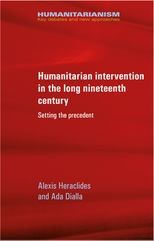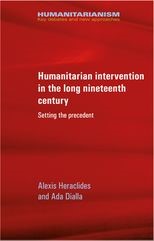 Humanitarian intervention in the long nineteenth century: Setting the precedent
Humanitarian intervention in the long nineteenth century: Setting the precedent
Contents
Cite
Throughout the long nineteenth century and until 1939, ‘intervention’ (originally a French term) or ‘interference’ (the original British term) was ‘Protean’, covering an array of manifestations ‘from a speech in Parliament by Palmerston to the partition of Poland’.1 Not only was the scope of intervention wide, but its meaning and consequences remained contentious.
The Argentinean diplomat and jurist Carlos Calvo points out, in his acclaimed 1870 treatise, that on intervention ‘there are almost as many different opinions as there are authors. Some admit it, approving intervention; others condemn it, repudiating it; for some it has become a right, others add the idea of duty; others see nothing else but a simple fact, a brutal fact, which has its place in history’.2 The situation remained the same well into the twentieth century. As Percy Winfield put it in the early 1920s, ‘[t]he subject of intervention is one of the vaguest branches of international law. We are told that intervention is a right; that it is a crime; that it is the rule; that it is the exception; that it is never permissible at all’.3
Following the Second World War the problem with intervention continued to be discussed in the international law and international relations literature.4 In the post-Cold War era, with increasing interventionism, interest hardly diminished, the main focus now being on humanitarian intervention, which is even more contentious.5
But two things are clear. Intervention meant then–and today6–‘coercive’, ‘dictatorial interference by a State in the [internal or external] affairs of another State for the purpose of maintaining or altering the actual conditions of things’.7 Moreover, non-intervention was–and is–the rule, intervention the exception.8
It is often assumed that the non-intervention norm was established in the Treaty of Westphalia (1648). In fact non-intervention was established as a principle of international law in the first half of the eighteenth century by jurists Christian Wolff and Emer de Vattel.9 Thereafter non-intervention became a fully fledged legal principle associated with the principles of sovereignty and independence. Half a century later, Kant lent considerable weight to this new norm in his quest for principles assuring peace, with his Preliminary Article 5 on non-intervention in his Toward Perpetual Peace (see chapter 5).
In the course of the long nineteenth century, five positions on the matter can be discerned in international law and international political theory: (1) strict adherence to non-intervention; (2) exceptions limited to instances of threats to national interests; (3) exceptions to include protracted civil wars when a state has collapsed into anarchy; (4) exceptions to include national struggles against alien rule, especially in order to offset a previous intervention in support of the incumbent government; and (5) exceptions to include intervening in order to stop massacres and other atrocities.
The English term ‘humanitarian intervention’ was coined by the British jurist and aesthete William Edward Hall in 1880 in his acclaimed International Law (renamed the very same year A Treatise on International Law).10 It appears in a footnote and not in the main text,11 which might imply that the author was unaware of having launched a new term or was reluctant to do so. In fact he had not conceived a new concept but the English term that was to stick, for other terms had previously been used, such as ‘intervention in the general interests of humanity’12 and ‘intervention for humanity’, which correspond to the French term in use, intervention d’humanité,13 or ‘intervention on the ground of humanity’, intervention ‘on behalf of the interests of humanity’,14 all with the same meaning.15
From the 1830s until the 1930s humanitarian intervention was understood as interfering ‘for the purpose of vindicating the law of nations against outrage’,16 ‘in the interests of humanity for the purpose of stopping religious persecution and endless cruelties in times of peace and war’.17 According to Antoine Rougier (in a seminal 1910 survey of the literature), ‘intervention on the grounds of humanity is properly that which recognizes the right of one state to exercise an international control over the acts of another in regard to its internal sovereignty when contrary to the laws of humanity’.18 Ellery Stowell (in 1921) defined humanitarian intervention, with the nineteenth-century experience in mind, ‘as the reliance upon force for the justifiable purpose of protecting the inhabitants of another state from treatment which is so arbitrary and persistently abusive as to exceed the limits of that authority within which the sovereign is presumed to act with reason and justice’.19
Unquestionably, humanitarian intervention as such is a nineteenth-century concept and doctrine. But the wider idea of rescuing those tyrannized and maltreated has older roots. It was arguably a Renaissance idea, though admittedly within a different normative context, when theology intermingled with the ‘law of nations’ (international law), then just taking its very first steps.
Notes
| Month: | Total Views: |
|---|---|
| November 2022 | 2 |
| December 2022 | 1 |
| January 2023 | 6 |
| February 2023 | 2 |
| March 2023 | 1 |
| April 2023 | 3 |
| May 2023 | 7 |
| July 2023 | 1 |
| August 2023 | 1 |
| September 2023 | 1 |
| October 2023 | 6 |
| November 2023 | 3 |
| December 2023 | 3 |
| January 2024 | 6 |
| February 2024 | 6 |
| March 2024 | 7 |
| April 2024 | 8 |


